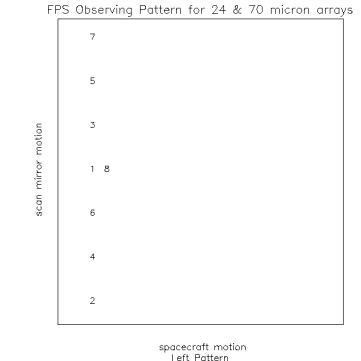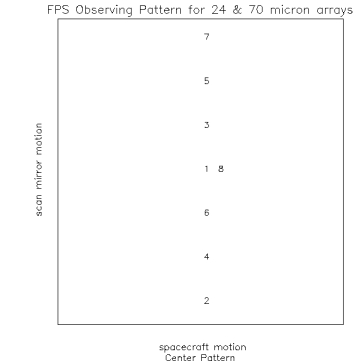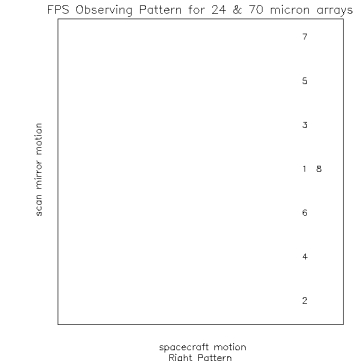70µm NF Focal Plane Survey, Fine
Principal: Jocelyn Keene
Deputy: Jane Morrison, Bill Wheaton
Data Monkey(s): Jane Morrison and Bill Wheaton
Priority: Critical
Downlink Priority: Normal
Analysis Time: Campaign R: 2880 minuntes, Campaign V: 2880 miuntes. Combining
the results from R and V: 120 minutes.
Last Updated:
Objective
To measure the pixel locations (i.e. array orientation, scale,and distortion)
as a function of scan mirror angle for the 70 µm narrow field array
configuration to an accuracy of 1.1 arcseconds relative to the PCRS.
Description
Use an IER based on the 70 µm Super-Resolution photometry AOT to measure
the locations on the sky of several positions on the array as a function of
scanning mirror angle.
This task is run in campaigns R and V. The data from each campaign is
processed desperately by the MIPS and IPF teams. The IPF team then combines
the results from both campaigns. The results from the IPF multi-run are used
to update Frame Table 15.
The frame table updates for all the campaigns can be found in the following
table: Frame Table Updates.
Data Collected
The observing strategy is exactly the same as the 70 µm Narrow coarse survey,
however the set of observations is repeated for a total of 1524 (762*2) observations.
Calibration Star
For the selected calibration star see the IER for this survey. The requirements
on the 70 µm coarse focal plane calibration star are as follows:
In CVZ
Mips requirements: stellar brightness corresponding to S/N of 30 (3 sec integrations)
0.212 Jy, K mag 1.25
Observing Strategy



Figure 1. Observing Pattern at 3 locations on the detector. Note size of
box is not the total size of the array but a portion of the central
region which depends on array and if it is a coarse or fine survey
Definitions:
W axis direction is defined by the Frame Table, and is always within +/- 90
degrees of the TPF z axis as projected on the sky. Motion along this axis corresponds to
motion in the spacecraft motion (left/right).
V axis direction is defined by the Frame Table, and is always within +/- 90
degrees of the TPF y axis as projected on the sky. Motion along this axis corresponds to motion
in the scan mirror direction (up/down).
W offset, the amount of motion in the W direction which results in the
spacing between left array, middle array and right array observations
V offset, the amount of motion in the V direction which occurs between a set of
observations.
70 Ám Coarse FPS observational parameters:
W offset = 50 arc seconds
V offset = 25 arc seconds
W dither = 7.5 arc seconds
V dither = 7.5 arc seconds
mirror locations for 1 position shown in figure 1.
- position 1 = 0
- position 2 = -75
- position 3 = 25
- position 4 = -50
- position 5 = 50
- position 6 = -25
- position 7 = 75
- position 8 = position 1 = 0
Observational Strategy
Step 1
- PCRS observation
Step 2 - (total of 11 observations)
- Position the telescope so the data falls on the left side of array
- Position star at position 1 in figure 1 (left), turn stim on take an observation
- Turn stim off
- Take 8 DCES at positions shown in figure 1 (left)
- Position star at position 1, turn stim on and take observation
- With star still at position 1 turn stim off and take observation
- dither in V and W
- Repeat above 11 observations.
Step 3
- Move the space craft according to the W offset (50 arc seconds), image should now
be on the center of the array.
- Position star at position 1 in figure 1 (middle), turn stim on take an observation
- Turn stim off
- Take 8 DCES at positions shown in figure 1 (middle)
- Position star at position 1, turn stim on and take observation
- With star still at position 1 turn stim off and take observation
- dither in V and W
- Repeat above 11 observations.
Step 4
- Move the space craft according to the W offset (50 arc seconds), image should now
be on the right side of the array.
- Position star at position 1 in figure 1 (right), turn stim on take an observation
- Turn stim off
- Take 8 DCES at positions shown in figure 1 (right)
- Position star at position 1, turn stim on and take observation
- With star still at position 1 turn stim off and take observation
- dither in V and W
- Repeat above 11 observations in step.
Step 5
- PCRS observation
Step 6: move telescope according to V offset (25 arc seconds) and repeat steps 1-5
Step 7: move telescope according to V offset (25 arc seconds) and repeat steps 1-5
Step 8: move telescope according to V offset (25 arc seconds) and repeat steps 1-5
Step 8: move telescope according to V offset (25 arc seconds) and repeat steps 1-5
Step 9: move telescope according to V offset (25 arc seconds) and repeat steps 1-5
Step 10: move telescope according to V offset (25 arc seconds) and repeat steps 1-5
Step 11: move telescope according to V offset (25 arc seconds) and repeat steps 1-5
Step 12: move telescope according to V offset (25 arc seconds) and repeat steps 1-5
Step 13: move telescope according to V offset (25 arc seconds) and repeat steps 1-5
Step 14: move telescope according to V offset (25 arc seconds) and repeat steps 1-5
Step 15: repeat entire set of observations (steps 1-15)
Number of observations from step 1-5, 66. Step 1-5 repeated 11 times for a total
of (66 * 11) = 726 observations. Repeat a second time for a total of 1452 observations.
Array Data Desired:
70 µm Narrow
Data Reformatting Option:
- Normal - One FITS multi-image extension file per AOR. (Output from MIPS DATPACK, one DCE in each image extension.
Task Dependencies
- MIPS-911: 70 µm Darks
- MIPS-313: 70 µm Narrow illumination correction
- MIPS-137: 70 µm Narrow Field Focal Plane Survey, Coarse.
- IPF run is to occur after FTU# 14 (PAC filer and OET CTA Frame Tool inputs)
Calibration Dependencies
- Calibration product needed:
- 70 µm Narrow IC
- 70 µm darks
- Items needed by IPF team for this task to run with the IPF filter software:
- IPF team Labeling convention for files: XXYYYZZZ.m where,
- XX for type of file (example FF for Offset file, IF for output data, CS for Centroid supplemental file)
- YYY for the version number, '001' to '499' for Coarse survey, '501' to '999' for Fine Surveys
- ZZZ for the Frame table number associated with the Prime Frame being calibrated. Use 118 for the 70 µm NF array. .
- CB file: The OET Centroid File and Generation Tool is run to generate a
centroid B file (CB file)
- A and As files: SIST generates a A and AS files (attitude history files)
and emails them to IPF team.
- FF file: The MIPS team generates an Offset file (match derived frames
to prime frames) and ftps to IPF team (this can be done before launch and has been).
- CS file: The MIPS team generated a CS file (Centroid supplemental file) to
IPF team. This can be done before launch and has been.
Output and Deliverable Products
- Output of MIPS DAT: calibrated data file with appropriated header keywords.
The name of this file will be "mips_YYY118.fits", where
where "YYY" is 3-digit string denoting run number, and "118" is
IPF code for 70 µm NF data.
This file is sent to B. Wheaton's centroiding program.
- Output from Centroid program: Centroid data file. The calibrated data is centroided and the centroided
data filename is CAYYY118.m, where the YYY is the version number. This file is
sent to the IPF team.
- Output from IPF team which the MIPS team analyzes:
- IF file: output data from a single IPF run.
- MF file: output data from a multi-run IPF run
- The FF file (offset file) and CS file (centroid supplemental file) have
been generated and sent to the IPF team. Unless the results from the coarse survey
result in significant changes to these files, these files will not be changed
for the fine survey.
Data Analysis
Task 138 is run both in Campaign R and Campaign V. The results from
both runs are used to update Frame Table # 15.
- Process data for Campaign R:
- JPL MIPL transfers downlink data to SSC.
- SSC downlink ops processes data and places results in sandbox.
- SSC MIPS IST uses FTZ to transfer data from sandbox to SSCIST21.
The MIPS IT team
repackages the data to run with the Arizona data analysis tool (DAT).
- The data are calibrated using the MIPS DAT.
- Run mips_sloper : with following options:
- mips_sloper filename
- IF we do not use the default directory for the calibration files. Then use
the -j option.
- -j dirname : directory below $MIPS_DIR/Cal to find calibration files.
- Run mips_caler : with following options:
- mips_caler -I illumination_correction_filename -D dark_filename-C pathname
- -C path is the path to where the calibration files live. If you do not use
the -C then the default will be used.
- -D dark filename.
- -I illumnation correction filename
- The calibrated data file mipsfps_YYY118.fits
(YYY a 3-digit integer string, identifying the run number) is a
FITS multi-extension image file, one extension per DCE.
- Run Xsloper_view and check to make sure data seems reasonable:
- The calibrated data file mipsfps_YYY118.fits
(YYY a 3-digit integer string, identifying the run number)
is placed on sscist21: /mipsdata/fps/inpdat.
File is linked to processing subdirectory
(currently /home/sscmip/users/waw/fps).
- The MIPS IDL Centroid File Generation tool, mipspos.pro,
is run according to detailed instructions in
sscist21L /home/sscmip/users/waw/fps/fps.doc.
- The output files CSYYY118.m and CAYYY118.m are placed on the TFS at SSC
and transfered to DOM at JPL.
- IPF team retrieves previously approved spreadsheet
and SSC's CA/CS files from DOM.
- IPF filter is run using input files: CB,A,AS,O, CA, CS files and the
previously approved spreadsheet.
- The output files (IF files) are placed on the DOM for MIPS team to analyze.
- End of Campaign R.
- The entire process above is repeated for Campaign V.
- Results from the IPF filter for Campaign R and Campaign V
are analyzed by the MIPS team and compared to one another for consistency.
- On approval of consistency, the IPF team runs the IPF multi-run tool
and produces an output file, MF, that is placed on the DOM.
Software Requirements
- STINYTIM for PSF generation.
- SSC downlink system.
- MIPS DAT
- IDL for IDL program mipspos.pro for star centroiding.
- At JPL, IPF Filter program.
Actions Following Analysis
- After each run 138-R and 138-V the MIPS team recieves the results from
the IPF team and reviews them.
- The MIPS team reviews the MF file from the multi-run IPF tool
and approves or disapproves.
- When approved, SSC generates mini-spreadsheet for review and approval
by MCCB, followed by handoff to JPL OET, and uplink of FTU #15.
Failure Modes and Responses
- Failure of one campaign (R or V) to produce useful data
- If one of the runs looks bad, then go back and analyze the data better.
We may need to plot the data to look for bad data, we may need to edit the
CA file and resend it to the IPF team.
- We might need to ask the IPF team to look closer at their analysis.
- If one set is bad and can not be fixed, then use data from other campaign, if data appear reasonable and change
is not large
- Results of R & V inconsistent, neither obviously bad, then average the results.
- Both results are bad - then reschedule observations.
Additional Notes





